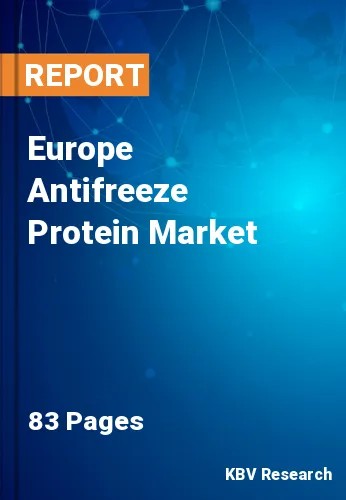Chapter 1. Market Scope & Methodology
1.1 Market Definition
1.2 Objectives
1.3 Market Scope
1.4 Segmentation
1.4.1 Europe Antifreeze Protein Market, by Type
1.4.2 Europe Antifreeze Protein Market, by Form
1.4.3 Europe Antifreeze Protein Market, by Source
1.4.4 Europe Antifreeze Protein Market, by End Use
1.4.5 Europe Antifreeze Protein Market, by Country
1.5 Methodology for the research
Chapter 2. Market Overview
2.1 Introduction
2.1.1 Overview
2.1.1.1 Market Composition and Scenario
2.2 Key Factors Impacting the Market
2.2.1 Market Drivers
2.2.2 Market Restraints
Chapter 3. Europe Antifreeze Protein Market by Type
3.1 Europe Type I Market by Country
3.2 Europe Type III Market by Country
3.3 Europe Antifreeze Glycoprotein Market by Country
3.4 Europe Others Market by Country
Chapter 4. Europe Antifreeze Protein Market by Form
4.1 Europe Solid Market by Country
4.2 Europe Liquid Market by Country
Chapter 5. Europe Antifreeze Protein Market by Source
5.1 Europe Fish Market by Country
5.2 Europe Others Market by Country
Chapter 6. Europe Antifreeze Protein Market by End-use
6.1 Europe Medical Market by Country
6.2 Europe Food Market by Country
6.3 Europe Cosmetics Market by Country
6.4 Europe Others Market by Country
Chapter 7. Europe Antifreeze Protein Market by Country
7.1 Germany Antifreeze Protein Market
7.1.1 Germany Antifreeze Protein Market by Type
7.1.2 Germany Antifreeze Protein Market by Form
7.1.3 Germany Antifreeze Protein Market by Source
7.1.4 Germany Antifreeze Protein Market by End-use
7.2 UK Antifreeze Protein Market
7.2.1 UK Antifreeze Protein Market by Type
7.2.2 UK Antifreeze Protein Market by Form
7.2.3 UK Antifreeze Protein Market by Source
7.2.4 UK Antifreeze Protein Market by End-use
7.3 France Antifreeze Protein Market
7.3.1 France Antifreeze Protein Market by Type
7.3.2 France Antifreeze Protein Market by Form
7.3.3 France Antifreeze Protein Market by Source
7.3.4 France Antifreeze Protein Market by End-use
7.4 Russia Antifreeze Protein Market
7.4.1 Russia Antifreeze Protein Market by Type
7.4.2 Russia Antifreeze Protein Market by Form
7.4.3 Russia Antifreeze Protein Market by Source
7.4.4 Russia Antifreeze Protein Market by End-use
7.5 Spain Antifreeze Protein Market
7.5.1 Spain Antifreeze Protein Market by Type
7.5.2 Spain Antifreeze Protein Market by Form
7.5.3 Spain Antifreeze Protein Market by Source
7.5.4 Spain Antifreeze Protein Market by End-use
7.6 Italy Antifreeze Protein Market
7.6.1 Italy Antifreeze Protein Market by Type
7.6.2 Italy Antifreeze Protein Market by Form
7.6.3 Italy Antifreeze Protein Market by Source
7.6.4 Italy Antifreeze Protein Market by End-use
7.7 Rest of Europe Antifreeze Protein Market
7.7.1 Rest of Europe Antifreeze Protein Market by Type
7.7.2 Rest of Europe Antifreeze Protein Market by Form
7.7.3 Rest of Europe Antifreeze Protein Market by Source
7.7.4 Rest of Europe Antifreeze Protein Market by End-use
Chapter 8. Company Profiles
8.1 Kaneka Corporation
8.1.1 Company Overview
8.1.2 Financial Analysis
8.1.3 Segmental and Regional Analysis
8.2 Unilever PLC
8.2.1 Company Overview
8.2.2 Financial Analysis
8.2.3 Segmental and Regional Analysis
8.2.4 Research & Development Expense
8.3 Nichirei Corporation
8.3.1 Company Overview
8.3.2 Financial Analysis
8.3.3 Segmental and Regional Analysis
8.3.4 Research & Development Expenses
8.4 A/F Protein Canada, Inc.
8.4.1 Company Overview
8.5 Sirona Biochem Corporation
8.5.1 Company Overview
8.5.2 Financial Analysis
8.5.3 Regional Analysis
8.5.4 Research & Development Expenses
8.6 Protokinetix, Inc.
8.6.1 Company Overview
8.7 Shanghai Yu Tao Industrial Co., Ltd.
8.7.1 Company Overview
8.8 Kodera Herb Garden Co., Ltd.
8.8.1 Company Overview
8.9 Rishon Biochem Co., Ltd.
8.9.1 Company Overview
8.10. MyBioSource, Inc.
8.10.1 Company Overview

